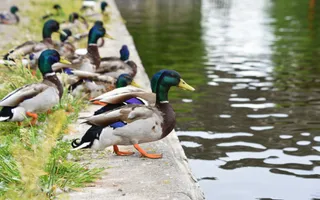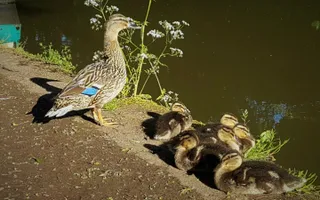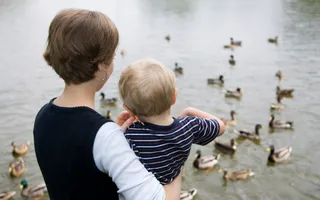The teal, our smallest native duck, has striking green wing patches. They're often seen in dense flocks across the UK.
Teal facts
Scientific name: Anas crecca
Family: Anatidae
Diet: Plants, seeds, small fish, molluscs and other aquatic invertebrates
Predators: American mink, foxes and birds of prey
Size: 33-38cm with a 61cm wingspan
Weight: 360g
Lifespan: Three years
About teals
Belonging to the dabbling duck group, the teal is a small, pretty duck with green colouring. Despite their small size, teals are surprisingly nimble on the ground and are known for their dramatic, rapid take-offs. Their short legs and compact bodies give them a stocky appearance.
Teals are somewhat shy by nature, often preferring the cover of reeds and vegetation. However, their distinctive 'krrck' call is loud and carries across the water.
Are teals rare in the UK?
Teals are considered rare as breeding birds in the UK, with only between 2,700 to 4,000 breeding pairs.
However, the population swells dramatically in winter when nearly half a million teals migrate south from their breeding grounds in northern Europe and Siberia. They gather in impressive numbers, forming large, tight-knit flocks, which can often be seen on reservoirs, flooded fields and other bodies of water.
During the breeding season, these birds are mostly found nesting in upland areas, favouring wetlands with dense vegetation. In the colder months, they become much more widespread and can be found on most bodies of water across the UK, including lowland reservoirs, lakes and even flooded fields.
What do teals look like?
Small, short and stocky, teals are one of the smallest ducks – much smaller than a mallard. They have pointed tails that sit high out of the water. They have large heads and short necks.
Adult male teals have grey bodies with a bold white stripe that runs from the wing joint to the breast. They have chestnut brown heads with the characteristic green from the eye to the base of the neck that gives them their name.
Female teals, while less colourful, are still attractive with their mottled brown plumage and a yellow streak on the tail. They resemble small mallard hens but can be distinguished by their smaller size.
Both sexes have a green patch on the wing – called a speculum – which is often only visible in flight.
What do teal ducklings look like?
Teal ducklings are tiny, resembling miniature versions of the adult females. Their fluffy plumage is brown on top and yellow underneath, a common colouration among dabbling ducklings.
Weighing just around 15 grams when they hatch, these ducklings are among the smallest in the duck family, but they are quick to grow and develop.
Audio: David Darrell-Lambert / xeno-canto.org
What do teals eat?
Teals are dabbling ducks, which means they feed primarily on the water's surface. They feast on a varied diet of aquatic vegetation and invertebrates, which they pick from just below the surface by upending themselves with their tails in the air.







